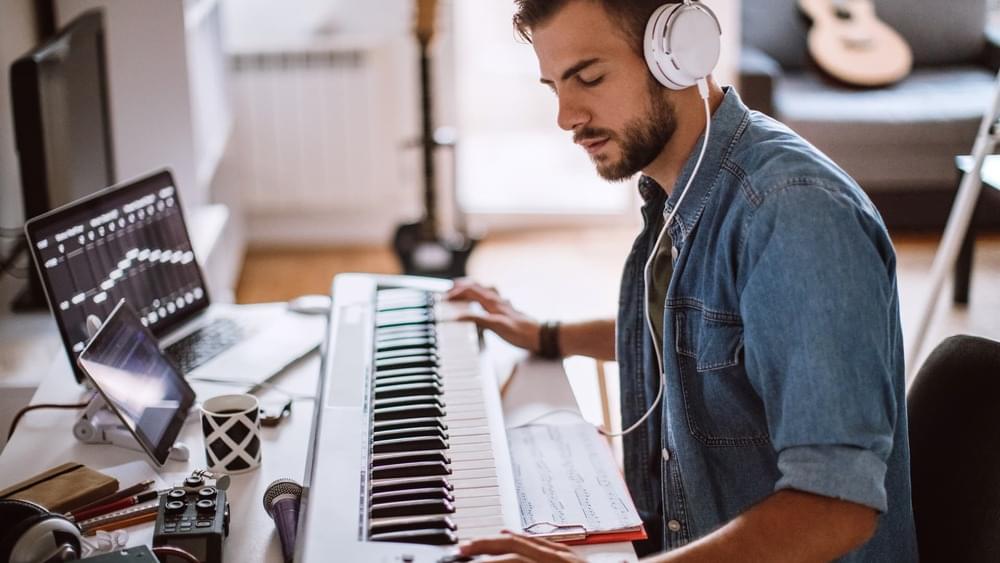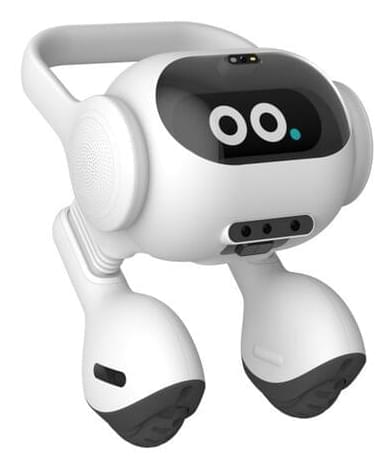Though there are AI tools that can create music, don’t expect them to replace your favorite artist any time soon. Here’s why.



More details about it will be revealed at CES 2024.
LG is going to start selling a compact bipedal robot that can roll around your house freely.
LG is going to start selling a compact bipedal robot that can roll around your house freely. The AI-powered robot, which will debut at CES 2024 in Las Vegas, has a wide range of capabilities — from notifying you that you left the AC on while you’re away to watching your pet while you’re at work. Like stationary smart home aids, like Alexa or Apple HomePod, LG’s robot can also tell you the weather and remind you to take your medications on time.
The robot is powered by Qualcomm’s Robotics RB5 Platform, which entails a mix of hardware and software that run the bot’s AI program. Some of these include its ability to recognize faces and voices, process the emotions of those around it and engage in conversation. LG says the bot will be able to greet you at your door, analyze your emotions and play music to either boost your good mood or lull you to sleep. It can even “emote” by changing its posture thanks to its articulated leg joints. Although it’s a cute feature, it might not have any practical use beyond making it approachable.
The robot is also equipped with a camera in its face, a speaker and various sensors throughout that give it the ability to navigate, speak and listen. It can also measure indoor air quality and temperature, however, it’s unclear if it can actually be linked to a smart home system and control your thermostat. LG has not yet responded to comment on this and said the price of the robot will be announced at a later time.
Last year, I edhost a thrilling conversation between @SabineHossenfelder, Carlo Rovelli, and Eric Weinstein as they debate quantum physics, consciousness and the mystery of reality. \
\
IAI Live is a monthly event featuring debates, talks, interviews, documentaries and music. LIVE. \
Watch the original video \
\
See the world’s leading thinkers debate the big questions for real, LIVE in London. Tickets: https://howthelightgetsin.org/\
\
To discover more talks, debates, interviews and academies with the world’s leading speakers visit https://iai.tv/\
\
We imagine physics is objective. But quantum physics found the act of human observation changes the outcome of experiment. Many scientists assume this central role of the observer is limited to just quantum physics. But is this an error? As Heisenberg puts it, \.
PBS Member Stations rely on viewers like you. To support your local station, go to: http://to.pbs.org/DonateSPACE
Sign Up on Patreon to get access to the Space Time Discord!
/ pbsspacetime.
If we ever want to simulate a universe, we should probably learn to simulate even a single atomic nucleus. But it’s taken some of the most incredible ingenuity of the past half-century to figure out how that out. All so that today I can teach you how to simulate a very very small universe.
Check out the Space Time Merch Store.
https://www.pbsspacetime.com/shop.
Sign up for the mailing list to get episode notifications and hear special announcements!
https://mailchi.mp/1a6eb8f2717d/space… the Entire Space Time Library Here: https://search.pbsspacetime.com/ Hosted by Matt O’Dowd Written by Euan McLean & Matt O’Dowd Post Production by Leonardo Scholzer, Yago Ballarini, Pedro Osinski, Adriano Leal & Stephanie Faria GFX Visualizations: Ajay Manuel Directed by Andrew Kornhaber Associate Producer: Bahar Gholipour Executive Producers: Eric Brown & Andrew Kornhaber Executives in Charge (PBS): Adam Dylewski, Maribel Lopez Director of Programming (PBS): Gabrielle Ewing Spacetime is produced by Kornhaber Brown for PBS Digital Studios. This program is produced by Kornhaber Brown, which is solely responsible for its content. © 2022 PBS. All rights reserved. End Credits Music by J.R.S. Schattenberg: / multidroideka Special Thanks to Our Patreon Supporters Big Bang Supporters Steffen Bendel Gautam Shine NullBlox. ZachryWilsn Adam Hillier Bryce Fort Peter Barrett David Neumann Charlie Leo Koguan Ahmad Jodeh Alexander Tamas Morgan Hough Amy Hickman Juan Benet Vinnie Falco Fabrice Eap Mark Rosenthal David Nicklas Quasar Supporters Glenn Sugden Dr. Sujasha Gupta Vaka Dr. Vikram Reddy Vaka Alex Kern Ethan Cohen Stephen Wilcox Christina Oegren xaexyz Mark Heising Hank S Hypernova Supporters john ibes Vyce Ailour Brandon Paddock Oneamazinguy Ken S Gregory Forfa Kirk Honour Mark Evans drollere Joe Moreira Marc Armstrong Scott Gorlick Paul Stehr-Green Russell Pope Ben Delo Scott Gray Антон Кочков John R. Slavik Mathew Donal Botkin John Pollock Edmund Fokschaner Joseph Salomone chuck zegar Jordan Young John Hofmann Daniel Muzquiz Gamma Ray Burst Supporters Kane Holbrook Bradley S. Isenbek Jason Bowen John Yaraee Ross Story teng guo Mason Dillon Harsh Khandhadia Thomas Tarler bsgbryan Sean McCaul Carsten Quinlan Susan Albee Frank Walker Matt Q WhizBangery MHL SHS Terje Vold Anatoliy Nagornyy comboy Andre Stechert Paul Wood Kent Durham jim bartosh Nubble Scott R Calkins The Mad Mechanic Ellis Hall John H. Austin, Jr. Diana S Ben Campbell Faraz Khan Almog Cohen Alex Edwards Ádám Kettinger MD3 Endre Pech Daniel Jennings Cameron Sampson Geoffrey Clarion Darren Duncan Russ Creech Jeremy Reed Eric Webster David Johnston Web Browser Michael Barton Mr T Andrew Mann Isaac Suttell Devon Rosenthal Oliver Flanagan Bleys Goodson Robert Walter Bruce B Mirik Gogri Mark Delagasse Mark Daniel Cohen Nickolas Andrew Freeman Shane Calimlim Tybie Fitzhugh Robert Ilardi Eric Kiebler Craig Stonaha Graydon Goss Frederic Simon Tonyface John Robinson A G David Neal justahat John Funai Tristan Bradley Jenkins Kyle Hofer Daniel Stříbrný Luaan Cody Thomas Dougherty King Zeckendorff Dan Warren Patrick Sutton John Griffith Daniel Lyons DFaulk Kevin Warne.
Search the Entire Space Time Library Here: https://search.pbsspacetime.com/

Purdue quantum researchers twist double bilayers of an antiferromagnet to demonstrate tunable moiré magnetism.
Twistronics isn’t a new dance move, exercise equipment, or new music fad. No, it’s much cooler than any of that. It is an exciting new development in quantum physics and material science where van der Waals materials are stacked on top of each other in layers, like sheets of paper in a ream that can easily twist and rotate while remaining flat, and quantum physicists have used these stacks to discover intriguing quantum phenomena.
Adding the concept of quantum spin with twisted double bilayers of an antiferromagnet, it is possible to have tunable moiré magnetism. This suggests a new class of material platform for the next step in twistronics: spintronics. This new science could lead to promising memory and spin-logic devices, opening the world of physics up to a whole new avenue with spintronic applications.
Let’s kick off the Holiday Season in style, shall we? Like, say, with a single few people even know exist, from a massive pop culture phenomenon of the early ’80s? YES PLEASE! This really needs no introduction. It’s KITT, the Amazing Car of Tomorrow, in full hero mode, Saving Santa from bad weather, and then making the rounds to bring joy and cheer on Christmas Morning — All told in an early ’80s rap, over an electro groove lifted from the Knight Rider theme song. Hopefully you’ve already hit play, but if you haven’t yet, HIT PLAY NOW! And if you have, then PLAY IT AGAIN! And of course, I’d like to wish you all a Verry Merry Christmas! Like it? Subscribe! Follow me at / djmikebrady I don’t own any of the rights associated with this music, I simply share so that it will be heard. #PlayingRecords #NeedleDrop #RecordCollection
In the grandeur of the universe, the tapestry of life may be woven from stranger threads than we ever dared to dream, and spun from materials far different to our own.\
Watch my exclusive video The Fermi Paradox Hermit Shoplifter Hypothesis: https://nebula.tv/videos/isaacarthur–…\
Get Nebula using my link for 40% off an annual subscription: https://go.nebula.tv/isaacarthur\
Get a Lifetime Membership to Nebula for only $300: https://go.nebula.tv/lifetime?ref=isa…\
\
Visit our Website: http://www.isaacarthur.net\
Join Nebula: https://go.nebula.tv/isaacarthur\
Support us on Patreon: / isaacarthur \
Support us on Subscribestar: https://www.subscribestar.com/isaac-a…\
Facebook Group: / 1,583,992,725,237,264 \
Reddit: / isaacarthur \
Twitter: / isaac_a_arthur on Twitter and RT our future content.\
SFIA Discord Server: / discord \
\
Credits:\
Silicon-Based Lifeforms \
Episode 426; December 21, 2023\
Produced, Written \& Narrated by: Isaac Arthur\
Graphics: Ken York / YD Visual\
Music Courtesy of Epidemic Sound http://epidemicsound.com/creator

The afterlife Jones made.
For as long as we have had history and likely before, people have contemplated a life after this one, but might we one day create artificial afterlives? And if so, will we create heavens or hells?\
Get Nebula using my link for 40% off an annual subscription: https://go.nebula.tv/isaacarthur\
Watch my exclusive video on Free Will \& Orch OR: https://nebula.tv/videos/isaacarthur–…\
\
Visit our Website: http://www.isaacarthur.net\
Join Nebula: https://go.nebula.tv/isaacarthur\
Support us on Patreon: / isaacarthur \
Support us on Subscribestar: https://www.subscribestar.com/isaac-a…\
Facebook Group: / 1,583,992,725,237,264 \
Reddit: / isaacarthur \
Twitter: / isaac_a_arthur on Twitter and RT our future content.\
SFIA Discord Server: / discord \
\
Listen or Download the audio of this episode from Soundcloud: Episode’s Audio-only version: / artificial-afterlives \
Episode’s Narration-only version: / space-habitats-narration-only \
\
Credits:\
Artificial Afterlives \
Science \& Futurism with Isaac Arthur\
Episode 399, June 15, 2023\
Written, Produced \& Narrated by Isaac Arthur\
\
Editors:\
Dillon Olander\
\
Graphics by: \
Jeremy Jozwik\
Ken York\
\
Music Courtesy of\
Markus Junnikkala, \
To claim your matching donation with Givewell, go to https://www.givewell.org and select Youtube & Isaac Arthur at checkout! What does science tell us about reality and are there pathways to control, change, or re-create it? Visit our Website: http://www.isaacarthur.net Join Nebula: https://go.nebula.tv/isaacarthur Support us on Patreon: / isaacarthur Support us on Subscribestar: https://www.subscribestar.com/isaac-a… Group:
/ 1,583,992,725,237,264 Reddit:
/ isaacarthur Twitter:
/ isaac_a_arthur on Twitter and RT our future content. SFIA Discord Server:
/ discord Credits: Reality Manipulation Episode 425; December 314, 2023 Produced, Written & Narrated by: Isaac Arthur Editor: Lukas Konecny Music Courtesy of: Steve Cardon.